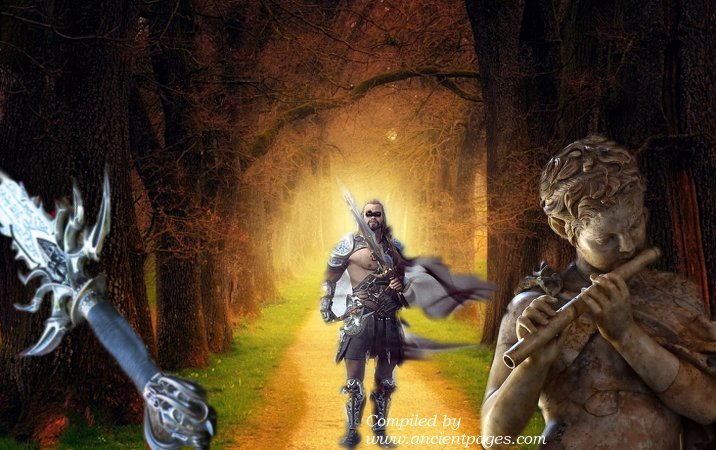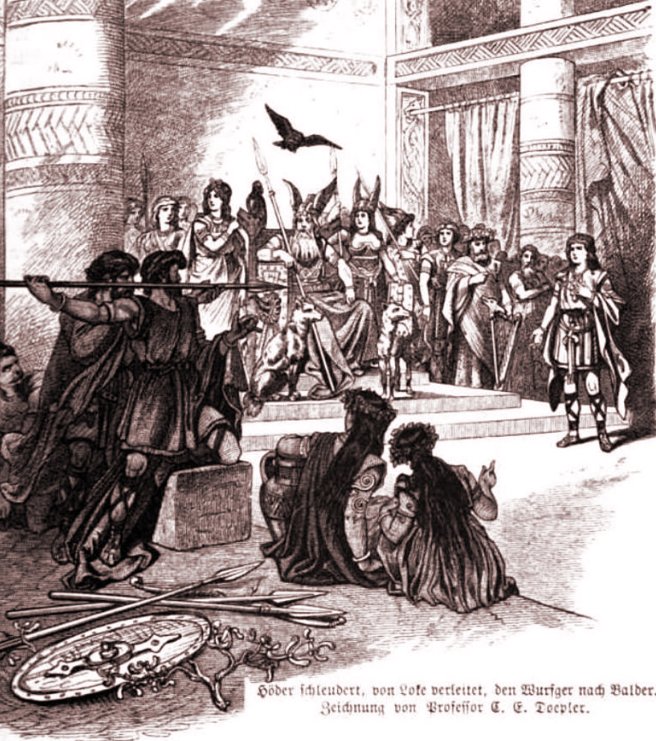A. Sutherland – AncientPages.com – In Snorri’s tale, Balder is the young son of Odin, the beloved of all in Asgard. He is invulnerable to all, even the most dangerous weapons, except for mistletoe, a tiny plant, which is his weakness.

Loki, a thief and trickster/shapeshifter responsible for all possible mischief and deception, knew about Balder’s weakness. He made a spear from mistletoe’s twig and helped Hoder shoot it at Balder, an Icelandic version of the story we described in one of our earlier articles.
However, there is also another version of the story of Balder and Hoder (Hödr).
It is somewhat different, perhaps a bit inferior, and probably not as popular as that of Snorri, but it is worth mentioning.
In ‘Gesta Danorum’ by a Danish historian, theologian, and author Saxo Grammaticus (c. 1160 – c. 1220), Balder is a warrior supported by a group of Valkyries, supernatural women with abilities to have the power to grant victory in battle. Among others, they had a magic food, which could make Balder invincible if necessary.
Being in love with Nanna, a human female and the daughter of King Gevar, Hoder and Balder are rivals. The demi-god Balder needs the Valkyries’ help, and so does Hoder, who cannot stand alone against his opponent. He, too, gets support from the women, who are eager to give him advice, and even a magical belt granting him victory.
Saxo Grammaticus describes Hoder as a good athlete, a boxer, a skilled swimmer, and highly experienced in using all kinds of weapons. He is also an accomplished harpist and talented singer who could evoke joy, hatred, sorrow, or desire with his incredible singing.
Hoder is probably the blind shepherd with the wet hat in the Finnish epic Kalevala. He kills a handsome young man and a hero, Lemminkäinen, with an arrow.
Hoder is undoubtedly a remarkable mythological figure, but it is not easy to win over Balder, the invincible demi-god and rival. To slay Balder, Hoder must gain a magic sword carefully guarded by Mimingus (Mimingr),) a woods satyr. Mimingus also possesses a bracelet that increases the wealth of its owner.

Guided by Loki, Hoder shoots the mistletoe at Baldr. Carl Emil Doepler (1824-1905) – Wägner, Wilhelm. 1882. Nordisch-germanische Götter und Helden. Otto Spamer, Leipzig & Berlin – Public Domain
Hoder has to make a long and hazardous journey to a mysterious land (probably the underworld), and he is determined to do so.
Riding in a carriage drawn by reindeer through a region of terrible cold and total darkness, he successfully captures the desperately needed sword.
Several battles were fought between Hoder and Balder. All the Aesir gods supported them, but none wanted to be involved. On one occasion, Balder was defeated, and on another, he won the battle over Hoder. Despite the victory, however, Hoder married the beloved Nanna.
Saxo says that, at last, these two (not exactly the best friends) met in the final battle after Hoder had already obtained the magic sword.
With this weapon, he badly wounded Balder, and in his last dream Hel Proserpine (Persephone) appeared to foretell his death, and so it happened.
After three days, Balder indeed died from the wounds he had been given to him by Hoder.
Odin Wants To Avenge The Death Of Beloved Son As Soon As Possible
Odin was so determined to avenge the death of his son Balder that he tried to gain the love of a princess called Rind. In Saxo’s account, Odin had a son with her named Boe (instead of Vali), and this young man avenged the death of Balder, killing Hoder.
As we see, the accounts of Balder’s death differ much. Snorri’s tradition is preserved in Iceland, and Saxo’s is in Denmark’s collection. It is hard to say which version is better or more reliable.
In all sources, however, there is mention of Balder’s magnificent funeral. Snorri describes how he was burned on his ship. Also, Saxo mentions the funeral and Balder’s burial in a mound. He also has a reference to the ship’s funeral.
Snorri says that the particular weapon that killed Balder was a mistletoe plant, but according to Saxo, this fatal weapon was a sword known in Norse heroic myths.
Mistletoe (not native to Iceland) was known in Norse heroic tradition and mentioned in the legendary Norse sagas.
Balder was invincible thanks to the Valkyries’ magic, but he was not invincible when Hoder used Mimingus’ magic sword. So, perhaps the sword’s surface had mistletoe traces; therefore, Balder was severely wounded and had to die.
Gods and heroes in the world of myths and legends have many counterparts. Saxo’s Balder and Hoder resemble two famous figures of Herebeald and Haethcyn, the sons of King Hrethel and the brothers of Hygelac in an Old English epic, Beowulf.
In an accident, Herebeald is killed with an arrow by his brother Haethcyn whose fate is also tragic because he dies in a battle.
The incident and the father’s grief over his ᴅᴇᴀᴅ boy in ‘Beowulf’ resemble that of Odin after the death of Balder in Snorri’s and Saxo’s versions.
In the famous ‘Beowulf’ story, we also encounter two princely warriors, one of whom, perhaps through the power of a curse or hostile magic, unintentionally becomes the slayer of the other.
Written by – A. Sutherland – AncientPages.com Senior Staff Writer
Updated on November 2, 2022
Copyright © AncientPages.com All rights reserved. This material may not be published, broadcast, rewritten or redistributed in whole or part without the express written permission of AncientPages.com





